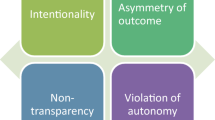Abstract
Bermúdez (Philosophy of psychology: a contemporary introduction, Routledge, London, 2005) identifies the “Interface Problem” as the central problem in the philosophy of psychology: how commonsensical psychological explanations can be integrated with lower-level (cognitive, biological, etc.) explanations? In particular, since folk psychology is meant to provide causal explanations on a par with, say, neurobiological explanations, the question of how to understand the relation between the two layers arises naturally. Donald Davidson claimed that the interface problem is actually ill-posed and put forward his version of the “Autonomy Picture”, the view known as anomalous monism. This work reviews Davidson’s proposal in the light of digital universes: we model the key claims of the theory using cellular automata and show that Davidson’s original version of the Autonomy Picture (which differs, in some respects, from what is discussed by Bermúdez) is immune to two arguments against autonomy.



Similar content being viewed by others
Notes
Bermúdez discusses at length also Dan Dennett’s position, especially as presented in Dennett (1991). In this work we shall focus on the version of AP developed by Davidson, even if some of Dennett’s remarks will turn out to be useful in later sections.
Thanks to an anonymous referee for bringing to my attention this important “switch” between the two levels.
Thanks to an anonymous referee for highlighting the importance of the differences between the “original” and the “modern” version of the autonomy picture.
The following section is a general introduction to CA qua digital universes—anyone familiar with the topic may safely skip through these introductory sections to read the main features of the chosen universe. For a philosophically oriented introduction to CA, see Berto and Tagliabue (2012); the interested reader may wish to consult Mainzer and Chua (2012) for a brief survey of the research field.
As a small illustration of this fact, consider that the Life Wiki (http://www.conwaylife.com/wiki/Main_Page) offers a downloadable package of more than 3,000 of different patterns (last update, August 2013).
As already noted, there are rules to predict the existence of gliders at t given the cell-by-cell matrix at t: therefore, Life supports strict vertical laws of the form ‘if cells are in such-and-such states at time t, a glider exists at time t’ and ‘if a glider exists at time t, cells are in such-and-such states at time t’. We shall see in later sections an example of CA where even vertical laws fail to be strict in Davidson’s sense.
References
Berlekamp, E., Conway, J., & Guy, R. (1982). Winning ways for your mathematical plays (Vol. 2). London: Academic Press.
Bermúdez, J. L. (2005). Philosophy of psychology: A contemporary introduction. London: Routledge.
Berto, F., & Tagliabue, J. (2012). Cellular automata. In Edward N. Zalta (ed.), The stanford encyclopedia of philosophy, http://plato.stanford.edu/archives/sum2012/entries/cellular-automata/.
Crutchfield, J. P., & Mitchell, M. (1995). The evolution of emergent computation. Proceedings of the National Academy of Sciences, 92(23), 10742.
Davidson, D. (1970). Mental events. In Foster, L., & Swanson, J. W. (eds.), Experience and theory. London: Duckworth.
Dennett, D. C. (1991). Real patterns. The Journal of Philosophy, 88, 27–51.
Epstein, J. M. (1999). Agent-based computational models and generative social science. Complexity, 4(5), 41–60.
Hanson, J. E., & Crutchfield, J. P. (1992). The attractor-basin portrait of a cellular automaton. Journal of Statistical Physics, 66, 1415–1462.
Hordijk, W., Crutchfield, J. P., & Mitchell, M. (1996). Embedded particle computation in evolved cellular automata. In Proceedings of the Conference on Physics and Computation.
Ilachinski, A. (2001). Cellular automata. Singapore: World Scientific Publishing.
Lewis, D. K. (1973). Counterfactuals. Oxford: Blackwell.
Mainzer, K., & Chua, L. (2012). The universe as automaton. From simplicity and symmetry to complexity. Heidelberg: Springer.
Marr, D. (1982). Vision. A computational investigation into the human representation and processing of visual information. San Francisco: W.H. Freeman and Company.
Miller, J. H., & Page, S. (2007). Complex adaptive systems. An introduction to computational models of social life. Princeton: Princeton University Press.
Tagliabue, J. (2013). A new kind of philosophy. In H. Zenil (ed.) Irreducibility and computational equivalence. Springer, Berlin.
Wolfram, S. (1985). Twenty open problems in the theory of cellular automata. Physica Scripta, T9, 170–183.
Acknowledgments
The author wish to thank Francesco Berto, Edoardo Datteri, Guglielmo Feis, Luca Gasparri, and two anonymous referees for helpful comments on earlier versions of this draft.
Author information
Authors and Affiliations
Corresponding author
Rights and permissions
About this article
Cite this article
Tagliabue, J. Anomalous Monism in a Digital Universe. Minds & Machines 24, 377–388 (2014). https://doi.org/10.1007/s11023-013-9332-4
Received:
Accepted:
Published:
Issue Date:
DOI: https://doi.org/10.1007/s11023-013-9332-4




